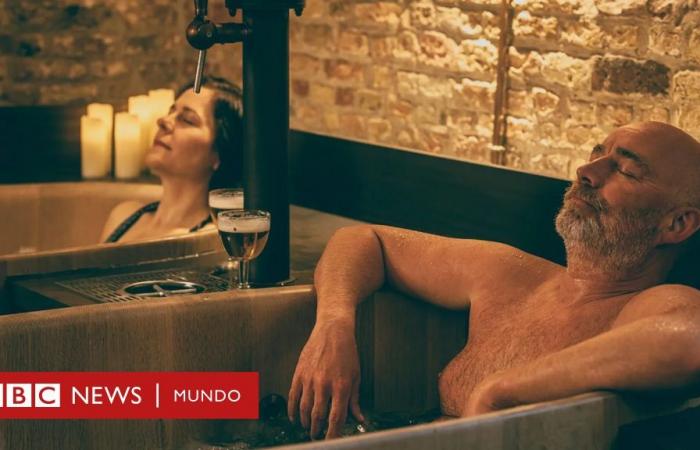Image source, WeWantMore/Bath&Barley
- Author, Norman Miller
- Role, BBC Travel *
-
1 hour
The image of one of the most important scientists in history, the 16th century Danish astronomer Tycho Brahe, looked down at me as I prepared to jump into a gigantic oak tub filled with 1,000 liters of water..
Nikola Skypalova helped me, holding large wooden ladles filled with key elements to add to the water.
“This is hops: it relieves stress in the body and also opens the pores,” he said, pouring it into the bathtub.
“And this is brewer’s yeast, which has a lot of B vitamins and makes you look younger.”
I was at Chateau Spa Beerland, one of the premier beer spas in the Czech Republic, the nation that gave rise to this idiosyncratic modern wellness trend in the 1980s.
Housed in an elegant national heritage building called U Zlaté Hrušky (At The Golden Pear) in Prague, this is where Tycho Brahe lived and worked since 1599.
Today, its beer spa rooms offer eye-catching decorative touches ranging from stained glass to astronomical murals.
Next to the tub was a giant bed of straw, providing a traditional Czech complement to the hops hot tub experience.
After the bath, the rough bed is intended to further stimulate the skin, and also, perhaps, provide a feeling of being closer to something natural.
Skypalova completed the bath with several ladles of beer.
It wasn’t just any beer but an unfiltered premium Czech beer which, because it still contains its complement of key ingredients such as yeast, is a more “live” form, retaining qualities such as high levels of vitamins.
Image source, Getty Images
If you’re thinking that pouring premium beer into a bathroom is a waste. Here are handy faucets that dispense an endless supply of the beverage right next to the tub.
I climbed in and pressed the jacuzzi button to make the bath bubble.
As the air filled with the aromas of beer, I poured a glass of delicious dark Krušovice (a traditional Czech brewery founded in 1581), took a piece of beer bread, whose healthy brown color comes from the beer used in its dough, and I sat down to reflect on the peculiar experience of the beer bath.
A globalized fashion
Proponents of the experience believe that the compounds in the bath’s bubbly concoction are good for the skin, relieving muscle stress and improving circulation.
Hop aromas are reputed to promote relaxation and improve mood.
And the enjoyable wellness trend has led to the opening of beer spas in various locations around the world, from Iceland, Japan and the US to Spain, Mexico and Argentina, among others.
The growing international popularity of the concept is due to the opportunity it offers to unite two popular sources of pleasure: spa relaxation and beer, with the added benefit of an attractive European label.
Eliza Oakden, spa director at The Norfolk Mead in England, offers another reason for the growing global emergence of beer spas.
“Spas tend to attract more women, so we thought they would appeal to both men and couples.”
At Bath & Barley, Belgium’s first beer spa, opening in 2023 in the city of Bruges, visitors can personalize their experience.
“You can prepare your own bath drink by choosing between different hops harvested by a Belgian farmer. These hops have different essences, but the beneficial effects are similar,” explains co-founder Louis Raesouv.
Image source, Getty Images
The Taaka Beer Spa in Strasbourg has been a pioneer of the experience of beer spa in France since its opening in 2022.
“The concept has sparked a lot of curiosity among local people, leading a significant number of people to come and try the spa,” says founder Naomie Crawshaw.
“It’s been fascinating to see how the concept has been embraced as a novel way to experience the region’s beer culture.”
Back in the heart of the Czech Republic, a variety of beer spas round out the capital’s half-dozen; some, like my experience in Prague, take place in memorable historical settings.
Inside another national monument, a neo-baroque house called U Zlatého Beránka (On the Golden Lamb), First Beer Spa Pilsen takes advantage of the heritage of a city that received brewing rights from King Wenceslas II back in the 13th century.
Image source, Getty Images
In the rough stone cellars of a 17th-century herbal liquor warehouse called Schloss Versailles, First Beer Spa has brought a fresh beer-based perspective to the bohemian town of Mariánské Lázně.
Its acclaimed traditional mineral spring spas date back to the 18th century, attracting famous historical visitors, from writers such as Kipling and Goethe to rulers such as the German Kaiser and Edward VII of the United Kingdom.
Well-being or pretension?
Almost all beer spas talk about beer baths dating back millennia, although this seems to imply conflating the historical existence of spas with the coexistence of beer, with no evidence that the two were linked in ancient times.
Image source, Getty Images
Czech beer spas regularly cite one of the many kings of the past, named Wenceslas, as a regular beer bather.
“That’s certainly not true,” says Libor Zajic, an expert in European beer history at Masaryk University in Brno, although he adds that one of the kings Wenceslas became the patron saint of Czech brewers in the 14th century.
“It’s a marketing gimmick by companies that operate beer spas, businesses that are a modern invention.”
“It is possible that beer was added to baths in the Middle Ages, like many other substances, but certainly not with a deeper intention.”
However, there may be a stronger case on the welfare side.
“Beer consists of three components that are beneficial for the skin: malted grains, yeast and hops,” says Dr. Cindy Jones, biochemist at Colorado Aromatics.
“Both malted grains and yeast contain vitamin B, which increases skin hydration and elasticity and reduces hyperpigmentation.
Image source, Getty Images
Hops, in particular, are rich in xanthohumul and humulone: the former, a powerful antioxidant that displays anti-cancer and anti-inflammatory properties, the latter, an antibacterial with promising skin-healing properties.
Studies have also found that hop extracts can decrease anxiety, mild depression, and stress.
“And hops are getting more scientific attention recently for skin care,” Jones continued, “they can increase collagen production to decrease wrinkles and decrease skin inflammation.”
Global brewing giant Carlsberg decided to take advantage of the beer cosmetics trend when it launched a Beer Beauty line in 2015.
In the Czech Republic, beauty company Manufaktura now has a growing range of stores across the country selling a wide range of products, including bath salts containing hops and barley extracts.
They can be used in the bathtub at home, but they don’t come with unlimited premium beer or delicious beer bread or the opportunity to lounge on a bed of straw, and it’s those details that make beer spas such a unique experience.
And remember that you can receive notifications in our app. Download the latest version and activate them.






